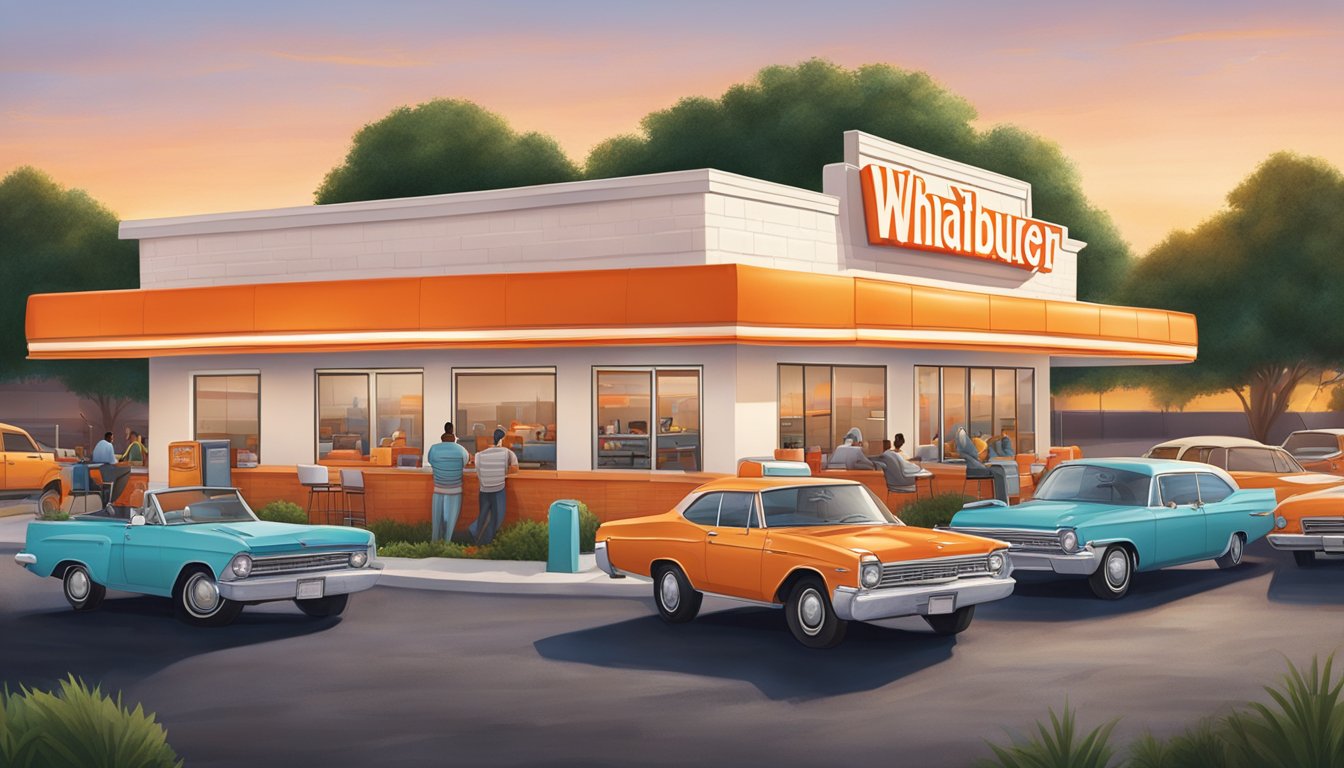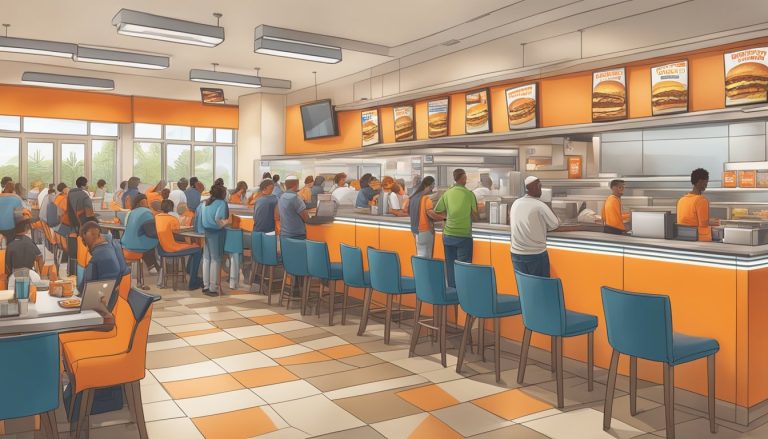Whataburger, a beloved Texas fast-food chain, has revolutionized late-night dining with its 24-hour service at many locations. Since the 1970s, this round-the-clock availability has catered to shift workers, night owls, and early risers alike, solidifying Whataburger’s place in Texas culture.
The introduction of 24-hour breakfast service at select Whataburger locations has significantly boosted breakfast sales and expanded the chain’s market reach. This strategic move has allowed Whataburger to tap into a previously underserved demographic, offering hot meals during unconventional hours when most competitors are closed.
As Whataburger continues to expand beyond Texas, its 24-hour model has become a key differentiator in new markets. The chain’s ability to serve breakfast from 11 PM to 11 AM daily has not only increased revenue but also strengthened customer loyalty, making Whataburger a go-to option for late-night and early-morning diners across its growing service area.
Historical Growth of Whataburger
Whataburger’s journey from a single burger stand to a beloved fast-food chain spans over seven decades. The company’s expansion reflects its deep Texas roots and strategic growth across multiple states.
Texas Roots and Expansion
Whataburger was founded in Corpus Christi, Texas in 1950 by Harmon Dobson. The first restaurant near Del Mar College quickly gained popularity for its oversized burgers. By 1960, Whataburger had grown to over 20 locations across Texas.
The iconic A-frame design, introduced in the 1960s, became a recognizable feature of Whataburger restaurants. This architectural choice played a significant role in the brand’s expansion and visibility.
In 1979, Whataburger introduced its breakfast menu, further solidifying its place in Texas food culture. The company began operating 24 hours a day in 1982, starting with three locations in Corpus Christi.
National Footprint and Franchising
Whataburger’s growth extended beyond Texas in the following decades. The company expanded its presence across the southern United States, maintaining a strong focus on customizable burgers and community involvement.
Franchising played a crucial role in Whataburger’s national expansion. This strategy allowed the brand to grow while preserving its commitment to quality and customer service.
By 2025, Whataburger operates over 800 locations across multiple states. Despite this growth, Texas remains the heart of Whataburger’s operations, with more than 750 restaurants in the Lone Star State.
The company’s expansion has fostered a cult following, with fans appreciating Whataburger’s iconic burgers and connection to local communities.
Whataburger’s Extension to 24/7 Service

Whataburger’s shift to 24/7 service transformed the fast food landscape, catering to customers at all hours. This move expanded accessibility and reshaped dining habits.
Transition to Round-the-Clock Operations
Whataburger embraced 24/7 service to meet growing demand for late-night dining options. This transition allowed the chain to serve customers beyond traditional hours, tapping into a new market segment.
The extended hours quickly became popular among night shift workers, students, and those with non-traditional schedules. Whataburger’s 24-hour availability made it a go-to spot for late-night cravings and early morning meals.
This change also positioned Whataburger as a community gathering place. The restaurant became a reliable option for diverse groups seeking food and socializing at unconventional hours.
Operating and Holiday Hours
Whataburger operates 24 hours a day, 7 days a week, 364 days a year. This commitment ensures consistent service for customers, regardless of time or day.
The chain’s holiday schedule includes:
- Open 24/7 on most holidays
- Christmas Eve: Close at 6 PM
- Christmas Day: Closed
- December 26: Reopen at 6 AM
Breakfast is served for 12 hours daily, from 11 PM to 11 AM. This extended morning menu caters to both early risers and night owls, boosting breakfast sales across varied time slots.
Impact on Breakfast Service

Whataburger’s 24-hour service model has significantly shaped its breakfast offerings and sales performance. The extended breakfast hours have become a key differentiator for the chain, attracting a diverse customer base and boosting revenue.
Breakfast Menu Launch and Evolution
Whataburger introduced its breakfast menu in the 1970s, starting with the iconic Breakfast on a Bun. The menu has since expanded to include popular items like the Honey Butter Chicken Biscuit and breakfast taquitos. The chain’s 24-hour operations allowed for an extended breakfast service from 11 PM to 11 AM daily.
This 12-hour window caters to early risers, night owls, and shift workers alike. The menu evolution has been driven by customer preferences and market trends. In recent years, Whataburger added pancakes to diversify its offerings and compete with other breakfast-focused chains.
Breakfast Sales Performance
The extended breakfast hours have significantly impacted Whataburger’s sales figures. Morning sales now account for a substantial portion of the chain’s daily revenue. The Honey Butter Chicken Biscuit has become a top-selling item, driving breakfast traffic.
Whataburger’s 24-hour model allows for seamless transitions between regular and breakfast menus, maximizing operational efficiency. This flexibility has helped the chain weather challenges like the 2015 egg shortage, which temporarily affected breakfast hours.
The introduction of the Breakfast Burger in 2019 further boosted sales by bridging the gap between breakfast and lunch offerings. This innovative approach has helped Whataburger maintain its competitive edge in the fast-food breakfast market.
Menu Innovation and Breakfast Offerings

Whataburger’s breakfast menu combines traditional favorites with innovative offerings. The chain has adapted to changing consumer preferences while maintaining its signature Texas-style flavors.
Standout Breakfast Items
The Honey Butter Chicken Biscuit stands out as a Whataburger breakfast icon. This sweet and savory creation features a crispy chicken strip nestled in a warm buttermilk biscuit, topped with honey butter sauce.
Breakfast sandwiches are another popular category. The Breakfast on a Bun comes with a choice of sausage or bacon, paired with a fresh egg and cheese on a toasted bun. For heartier appetites, the Taquito with Cheese offers a handheld option filled with scrambled eggs, cheese, and a choice of bacon or sausage.
Whataburger’s biscuits and gravy provide a comforting Southern classic. The chain also offers customizable breakfast platters, allowing customers to mix and match their favorite items.
Healthier Options and Dietary Trends
Whataburger has introduced lighter breakfast options to cater to health-conscious customers. The Breakfast Bowl features scrambled eggs, potato chunks, and a choice of bacon or sausage, providing a lower-carb alternative to traditional breakfast sandwiches.
For those seeking plant-based options, Whataburger now offers a vegetarian breakfast taco. This item includes egg whites, potato chunks, and cheese in a soft tortilla.
The chain has also improved its ingredient sourcing. Whataburger now uses cage-free eggs in all of its breakfast items, responding to consumer demands for more ethical food production practices.
Customization plays a key role in Whataburger’s breakfast menu. Customers can modify most items to suit their dietary needs, such as opting for egg whites or removing cheese to reduce calorie and fat content.
Consumer Habits and Preferences
Whataburger’s 24-hour operations cater to diverse customer needs and have shaped dining patterns in Texas. The availability of round-the-clock service influences when and how customers choose to dine.
Identifying Core Customers
Whataburger’s core customers include shift workers, night owls, and early risers. Healthcare professionals, emergency responders, and factory workers rely on Whataburger for meals during unconventional hours.
College students and young adults often visit late at night or in the early morning. These groups appreciate the chain’s consistent quality and convenient options.
Families and daytime diners still form a significant customer base. They value Whataburger’s made-to-order approach and table service, setting it apart from typical fast-food experiences.
Impact of 24-Hour Availability on Consumer Behavior
The 24/7 model has transformed eating habits in Texas. Late-night dining has become a cultural norm, with Whataburger serving as a social hub after events or nights out.
Drive-thru service sees increased usage during off-hours. This option appeals to customers seeking quick, contactless transactions at any time.
Online ordering and delivery platforms have further expanded Whataburger’s reach. Customers can now satisfy cravings without leaving home, regardless of the hour.
TikTok and social media have popularized “Whataburger runs,” encouraging spontaneous visits. This trend particularly resonates with younger consumers, driving late-night sales.
Competitive Analysis in the Fast-Food Industry

The fast-food landscape is fiercely competitive, with major chains vying for market share through diverse strategies. Whataburger’s unique positioning and operational choices set it apart from industry giants.
Comparison with Industry Giants
McDonald’s dominates the fast-food sector with its global presence and extensive menu. The chain’s market segmentation targets a wide customer base, with a slight majority of male patrons. In contrast, Whataburger focuses on regional expansion, growing from 828 units in 2019 to 997 stores by the end of 2023.
Taco Bell and Starbucks differentiate themselves through specialized offerings. Whataburger, however, competes directly with burger-centric chains. Its 24-hour service at many locations gives it an edge in the late-night market, a segment often underserved by competitors.
Fast-food giants prioritize rapid expansion and standardization. Whataburger’s approach emphasizes quality and regional appeal, similar to In-N-Out’s strategy of controlled growth and fresh ingredients.
Niche Positioning of Whataburger
Whataburger’s 24-hour service model caters to a specific demographic: late-night diners. This strategy has secured the chain a strong position in the after-hours dining market, distinguishing it from competitors with limited operating hours.
The brand’s focus on breakfast offerings further sets it apart. While many chains serve breakfast, Whataburger’s round-the-clock availability of morning menu items appeals to non-traditional breakfast consumers.
Whataburger’s expansion to 14 states, compared to In-N-Out’s presence in 7, demonstrates a measured growth strategy. This approach allows the chain to maintain quality standards while gradually increasing its footprint.
Drive-through service remains a key component of Whataburger’s operations, aligning with industry trends towards convenience and speed. The combination of drive-through efficiency and 24-hour service strengthens Whataburger’s competitive position in the fast-food market.
Brand Loyalty and Community Involvement
Whataburger’s 24-hour service has fostered intense brand loyalty and deep community connections. These factors contribute significantly to the chain’s success, particularly in breakfast sales during non-traditional hours.
Cultivating a Cult Following
Whataburger’s round-the-clock availability has created a devoted fan base. Customers know they can rely on Whataburger at any time, day or night. This dependability has led to the formation of a cult-like following, especially in Texas and other southern states.
Late-night diners and early risers alike have made Whataburger a part of their routines. The chain’s consistency in quality and service, regardless of the hour, reinforces this loyalty. Social media has amplified this devotion, with fans sharing their Whataburger experiences online.
The company’s expansion into new markets, such as Las Vegas Strip and Oklahoma, has been met with enthusiasm from existing fans and curiosity from new customers.
Local Community Engagement
Whataburger actively participates in local events and supports community initiatives. This involvement strengthens its ties with customers beyond just serving food. The chain often sponsors local sports teams and school events, building goodwill among residents.
In Georgia, Whataburger has been featured in the Forsyth County News for its community outreach efforts. These activities range from fundraisers for local charities to providing meals during natural disasters.
By engaging with communities, Whataburger creates a sense of belonging among its customers. This connection encourages repeat visits and word-of-mouth recommendations, boosting breakfast sales across all hours.
Marketing Strategies and Public Perception

Whataburger’s 24-hour locations have significantly influenced their marketing approach and public image. The company has employed innovative tactics to promote their round-the-clock availability and drive breakfast sales.
Leveraging Social Media Platforms
Whataburger has embraced social media to connect with customers and boost awareness of their 24/7 offerings. The brand’s TikTok account features entertaining content showcasing late-night menu items like shakes and bacon-topped burgers. These posts often go viral, attracting younger audiences to visit during non-traditional hours.
Twitter campaigns highlight the convenience of grabbing coffee and breakfast at any time. User-generated content of community gatherings at Whataburger locations in the early morning hours further reinforces the brand’s position as a social hub.
Public Endorsements and Legal Matters
Celebrity endorsements have played a crucial role in shaping Whataburger’s public perception. Texas-based musicians and athletes frequently mention the chain’s 24-hour availability in interviews and social media posts. This organic promotion has strengthened the brand’s association with Texas culture.
The Texas Legislature’s recognition of Whataburger as a state treasure has bolstered its reputation. However, the company faced legal challenges regarding overtime pay for overnight shift workers. Whataburger addressed these issues transparently, maintaining public trust.
The chain’s iconic spicy ketchup and customizable burger options have become talking points in marketing materials, emphasizing the unique experience available at any hour.
Future Prospects and Expansion Plans

Whataburger is poised for significant growth and market expansion in the coming years. The iconic Texas chain aims to leverage its 24-hour operations and strong breakfast sales to fuel ambitious expansion plans.
Projected Growth
Whataburger currently operates over 1,000 locations across 16 states. The company plans to open 50-60 new restaurants annually over the next five years. This aggressive growth strategy will increase Whataburger’s footprint by 25-30% by 2030.
New locations will feature updated designs that incorporate renewable resources and energy-efficient equipment. LED lighting and other sustainable elements will reduce environmental impact while maintaining the chain’s iconic A-frame architecture.
New Market Penetration
Whataburger is targeting expansion into new states beyond its traditional Southern stronghold. The company has identified potential markets in the Midwest and Mid-Atlantic regions.
Franchising will play a key role in this expansion. Whataburger plans to partner with experienced multi-unit operators to accelerate growth in new territories. The chain will carefully select franchisees who can maintain its high standards and 24/7 operating model.
Preserving Whataburger’s Texas culture and values will be crucial as it enters new markets. The company will emphasize its commitment to fresh, made-to-order food and friendly service to differentiate itself from competitors.




